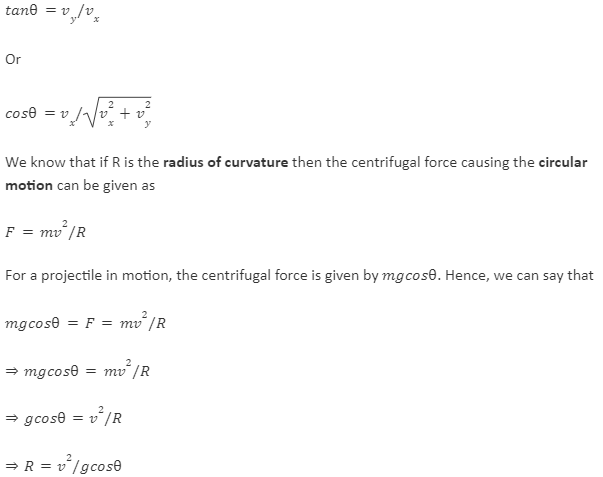The world of physics has amazing concepts that define the basis of things happening around us. Be it the rotation of the earth, or the speed of a moving car, physics can explain every element of it. Just like that, it explains to you different kinds of motion.
Motion is defined to be the movement along which the object changes its movements. It is calculated in terms of distance, velocity, acceleration, speed, and time. One kind of motion is circular motion. This motion involves an important concept, the radius of curvature.
The radius of curvature is important in the calculation of circular motion. Therefore, understanding the concept of circular motion should be the first step. We will then proceed in understanding what the radius of curvature is.
What Is Circular Motion?
In the most generic sense, circular motion is the motion that occurs on the circumference or the outer ring of a circle. It is also the rotation that takes place around the circular path. When the circular motion fluctuates in rate, the motion can be determined as uniformity or non-uniformity.
There are various day-to-day examples of circular motion. For instance, the ceiling fans at your home. When you look at its motion, it is in a circular motion. Another example is, the top you play with. As soon as you start playing, the top moves in a circular motion.
More specific examples of circular motion can be from various fields. The satellite that orbits around the Earth is in a circular motion. The rotation of planets in the solar system is one more example defining circular motion. With this, the magnetic field, mechanical equipment, and various other objects exert circular motion.
Like everything that has variations, there are also two main types of circular motion explained further.
Types of Circular Motion
There are two main types of circular motions. These are- uniform circular motion and non-uniform circular motion. These are elucidated below.
Uniform Circular Motion:
Uniform circular motion is defined as the motion when an object moves in a circular path at a constant speed. That is, the speed of each moving object in a circular path is defined to be constant in speed and distance.
For instance, consider the blades of the ceiling fans. Once you switch on the fan, the blades continue rotation at a constant speed. There are no fluctuations in the movement of the blades. Here again, the space or the distance between each blade of the fan remains the same. It does not change over time.
Non-Uniform Circular Motion
Non-uniform circular motion is defined as the motion where an object moves in a circular motion at different speeds. Here, the object is in a circular motion, but the speed fluctuates and remains not constant.
For instance, consider the ball you are playing with. The ball that is thrown, will move in a circular motion. However, the speed that it moves in would not remain constant. Rather, the speed of this particular circular motion will be more in the beginning and decrease over distance. In other cases, if the ball is thrown towards you or swung, the speed of its circular movement keeps changing.
These are two main classifications of circular motion. An important concept of circular motion is the radius of curvature. Let us know what it is.
Radius Of Curvature In Circular Motion
In a circular motion, there are three concepts along with the radius of curvature. It is the projectile, trajectory path, and radius of curvature.
The projectile occurs when there is no force acting except gravity. For instance, if you throw a ball upwards, the only force is gravity. That is, as soon as the ball is up, the only force that is acting at that point of time is gravity. This is the projectile.
A trajectory path is an expected path in which the circular body is intended to move. It is determined by the circular arc that is made by the radius of curvature. Here, the radius of curvature is the radius of the circular arc drawn.
In a more specific term, the radius of curvature is drawn at any point of the projectile in motion. This radius of curvature is the radius of a circular arc drawn at a particular point of time and this gives the trajectory of the object in a circular motion.
Now, the question is how do we determine the radius of curvature?
We know that force influencing the projectile is the force of gravity, mg, which acts downwards. As we the component of gravitational force perpendicular to velocity vector is mgcos .
There is an angle made by the velocity vector at the particular point of the trajectory. This can be explained with the following equative relation

This formula gives the radius of curvature of the projectile at any point in its trajectory.
Conclusion
The physics world defines various types of motion. One of them is the circular motion. An integral part in understanding circular motion is radius of curvature. In our day to day life, we will come across various objects that move around in circular motion.
In the most generic sense, circular motion is the motion that is calculated when the object moves in a circular path. There are two classifications of circular motion. They are- uniform and non-uniform circular motions.
The radius of curvature in a circular motion is determined by other factors that are the projectile, circular arc, and trajectory path. The radius of curvature is drawn at any point of the projectile in motion. This radius of curvature is the radius of a circular arc drawn at a particular point of time and this gives the trajectory of the object in a circular motion.
 Profile
Profile Settings
Settings Refer your friends
Refer your friends Sign out
Sign out






